Travis Olander 08.23.24
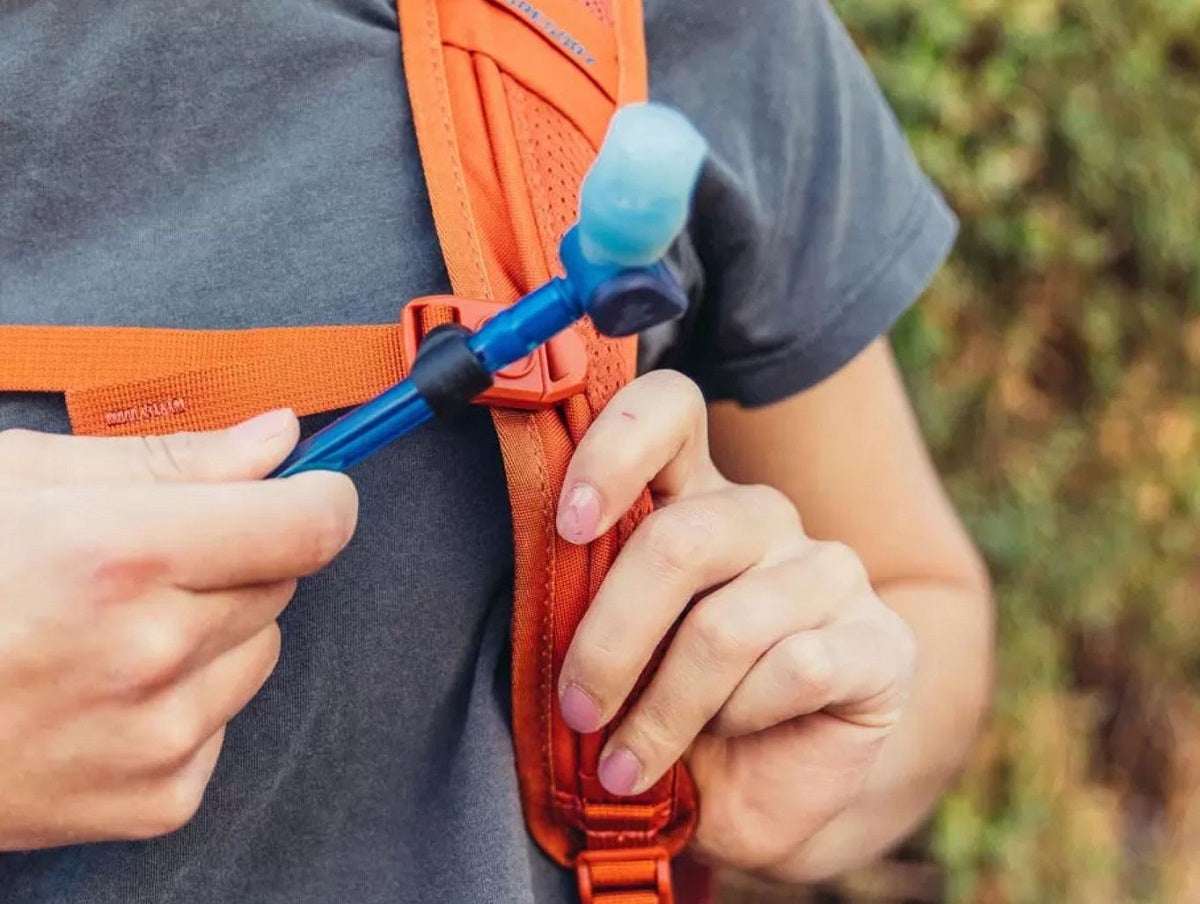
We recently covered just how quickly high heat and dehydration can kill your hike (or you). Indeed, summers are getting hotter across the country, bringing potentially lethal temperatures with them. In other words, it’s more important than ever before to bring enough water to replenish what you lose to sweating on those dusty trail runs or day hikes. We’re talking about hydration packs – small backpacks specifically designed to carry all the water you need, usually in the form of a bladder with a flow tube that acts as a spigot. But not all hydration packs are created equal. The amount of water you need also depends on where and how you’re trekking. Let’s look at the Best Hydration Packs for 2024 and beyond.
What’s in a Hydration Pack?
Before we review our top picks, consider these factors when selecting your own hydration pack.
Water Capacity
Water’s heavy. Each liter weighs about 2 pounds. Any experienced hiker knows it’s the top compromise to keep in mind when packing for any trek. Water capacity’s the most important thing to consider when you’re picking a hydration pack – too little water won’t save you, but too much adds unnecessary bulk to your kit. Here are some general guidelines:
- 1 to 1.5 liters: Good for short roundabout hikes (2 to 4 miles) on easy, well-trafficked trails.
- 2 to 2.5 liters: Best suited for longer distances (4-7 miles) on moderate trails.
- 3+ liters: Necessary for all-day hikes and remote, difficult trails with big elevation changes.
Overall Capacity
Most hydration packs have additional storage capacity for food, small items, and other gear. Keep these other guidelines in mind when you’re combining water capacity with overall carrying capacity:
- 5 liters (or less): These tiny packs are designed almost exclusively to carry water, and little else. You may be able to stuff a protein bar and some car keys in these bags, but their primary purpose remains providing hydration, and little more. These are best suited for trail running and those short, 2- to 4-mile hikes.
- 6 to 10 liters: These packs are still small and compact, but they afford enough capacity to carry a full meal and some extra clothing. These are great for cold-water situations, allowing you to bring (or stow) extra layers as needed. In addition to a water bladder, they can also hold a few extra bottles of water, making them good for those 4- to 7-mile hikes that last a few hours.
- 11 to 20 liters: These packs are good for long, remote, all-day hikes hikes, extended mountain biking, and long-range trail running.
- 20+ liters: These hydration packs provide some capacity for ultralight overnight camping. You can typically pack 2 to 3 meals, a change of clothes, and strap an ultralight tent to the bottom.
Best Hydration Packs: Our Top Picks for 2024
Now you’ve got a general sense for how much water and overall storage capacity is best for your outdoor rucks. Let’s cover our top hydration pack picks in each category for 2024.
Gregory Nano 22 H2O – Best Overall Hydration Pack
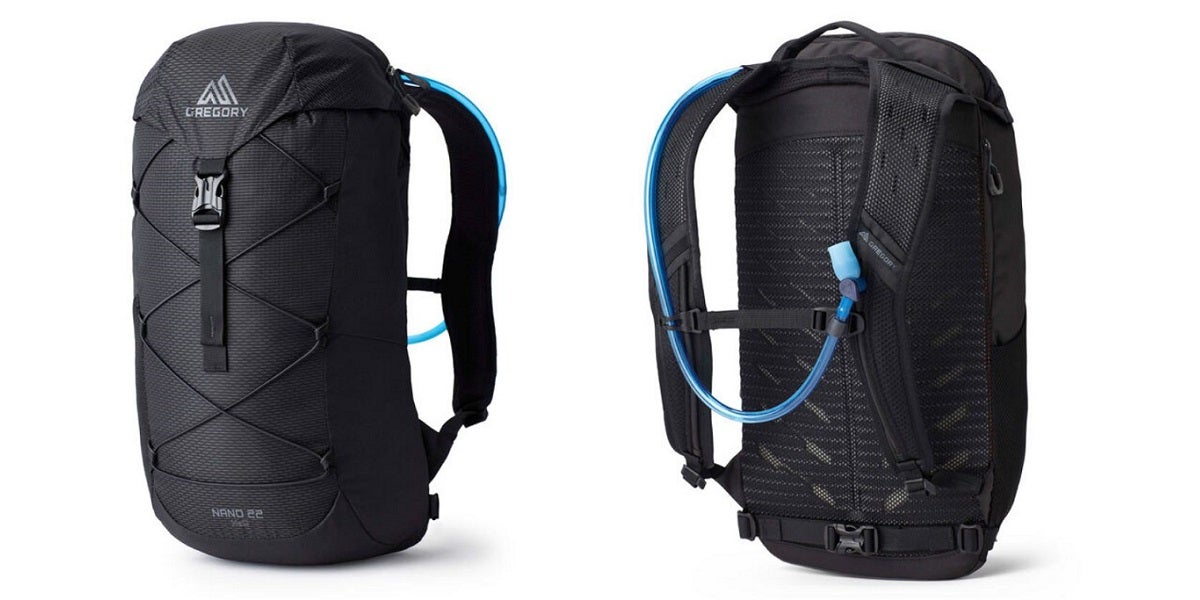

Specifications
- Water Capacity: 3 L
- Gear Capacity: 22 L
- Compartments: Four
- Dry Weight: 19.4 Oz.
Features
- Quick-drying, bacteria-resistant, 3-liter hydration bladder
- Convenient top zipper pocket for stashing small bits
- Side mesh bottle holder for extra water capacity
- Front bungee system for strapping exterior gear
- Easy-pull top draw cord for quick storage access
- Removable lightweight buckle cummerbund
Three liters of water storage, 22 liters of gear storage, all packed into a ripstop bag measuring just 20″ tall, 10.5″ wide and 7.25″ deep, and for under $100 – there are plenty of reasons the Nano H2O from Gregory is the crowd favorite for hydration packs. It’s our favorite, too.
Made from 210- and 450-D ripstop nylon, the Nano H2O’s light but tough, and water-resistant. And, despite its more than 100 ounces of water capacity, it manages to stay snug and comfy for long stints in the backcountry – partly thanks to its low-profile but effective waist strap, which helps distribute the weight of a full bladder, taking some of the brunt off your shoulders.
The internal bladder’s designed well, too. A quick-disconnect hose, thick welds, and a contoured shape all contribute to a simple but effective water bag that mitigates the risk of mold and bacterial growth, thanks also to its quick dry time.
The 22 liters of gear storage makes the Nano H2O a perfect two-for-one hydration pack and overnight backpack for longer hikes and single-night camps, with enough capacity inside and outside (thanks to the bungee cords) to lash down an ultra-light tent and stuff in a warm-weather sleeping bag.
Nathan TrailMix 12-Liter 2.0 Vest – Best Ultra-Light Option
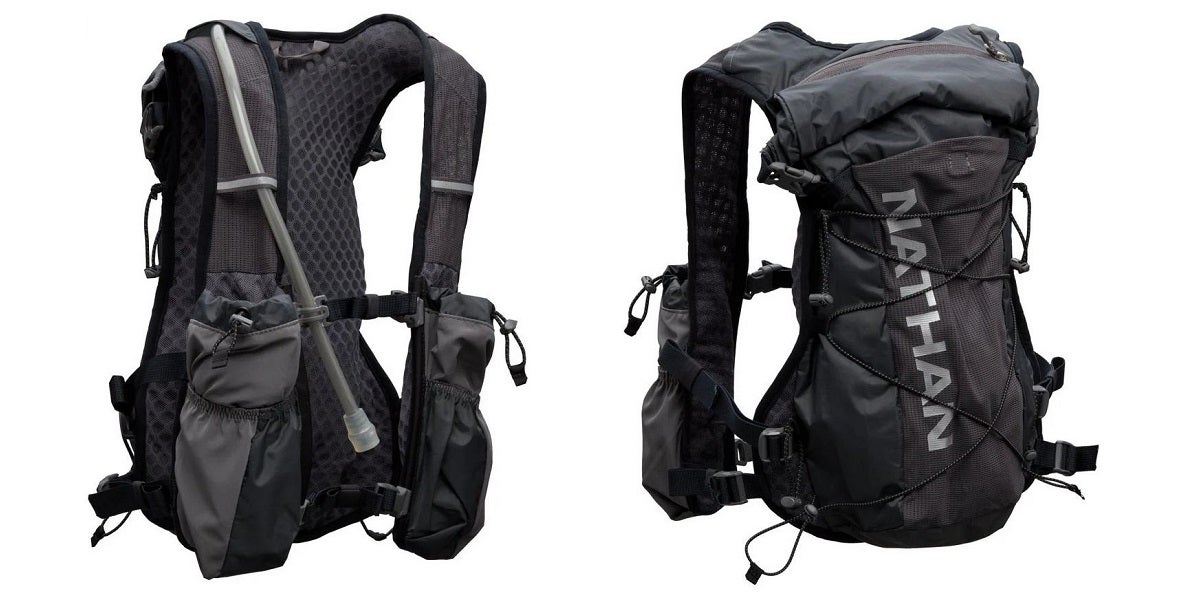

Specifications
- Water Capacity: 1.5 L
- Gear Capacity: 12 L
- Compartments: Six
- Dry Weight: 14 Oz.
Features
- (4) front bottle pockets fit up to 20 fl. oz. bottles each
- Backside zippered pocket for 1.5-liter hydration bladder
- Left- or right-handed hydration hose fitment
- Internal compression straps to secure loads
- Breathable mesh back improves ventilation
- Separate roll-top pocket for gear storage
The second iteration of Nathan’s TrailMix Hydration Pack is as close as you’ll get to a straight runner’s vest, while still affording day-hike features and storage (12 liters of storage, to be precise). Available in light blue or dark gray, the TrailMix offers 1.5 liters of onboard water storage via the included bladder. There’s a separate compartment out back for storing gear, plus front pouches with cinch straps for stowing additional water bottles – or food, a handheld GPS, or any other small bits n’ baubles you want quick access to.
With a dry weight of just 14 ounces (~0.87 lbs), it’s by far the lightest and smallest hydration vest that offers extra storage beyond just a bladder and hose. Two chest straps, and four adjustable lateral straps help keep the TrailMix snug and secure, with a comfortably raised and compressed center of gravity.
CamelBak Classic Light Pack – Best Dedicated Mid-Size Pack
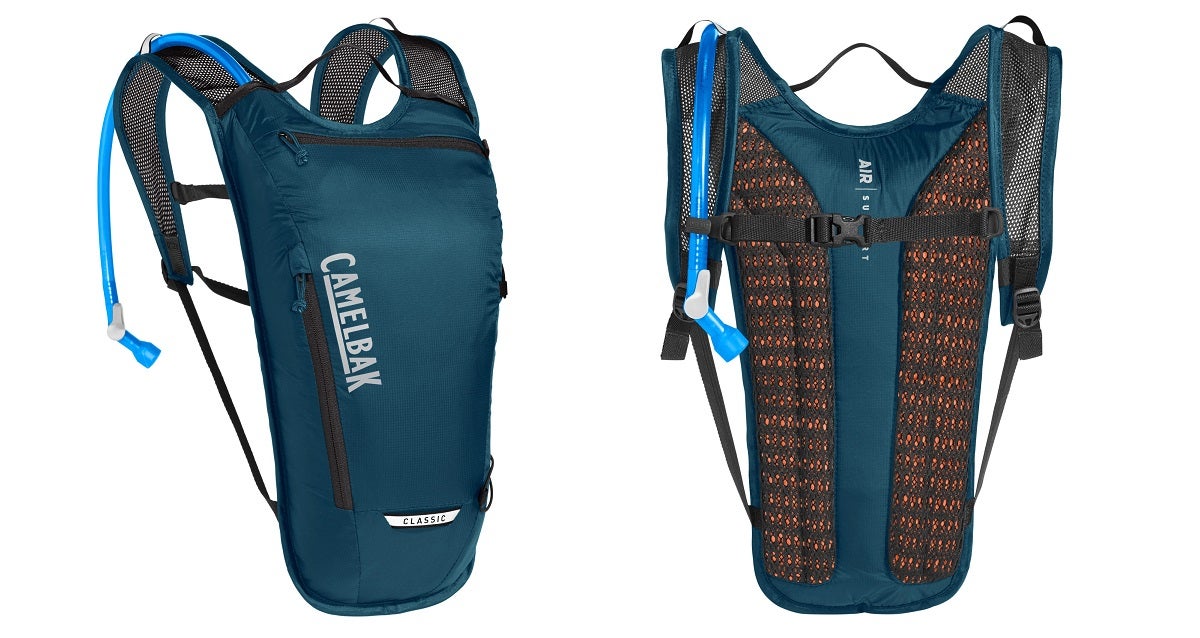

Specifications
- Water Capacity: 2 L
- Gear Capacity: 4 L
- Compartments: Two
- Dry Weight: 13.7 Oz.
Features
- “Air Support” back panel with ventilated harness
- Ultralight ripstop construction (50-/135-Denier)
- 100% mesh, single adjustable shoulder straps
- Internal compression straps to secure loads
- Breathable mesh back improves ventilation
- Separate roll-top pocket for gear storage
The simple, dedicated, bladder-only pack that provides mid-range water capacity is, in fact, one of the most popular options – and no one does it better than CamelBak. Their Classic Light Hydration Pack provides everything you need, and nothing more.
Extra ventilation throughout the backside and mesh shoulder straps help keep things cool, while the ripstop nylon sheds extra weight without any risks of tearing or fraying under load. The included 2-liter bladder provides a happy middle ground in water capacity, providing enough liquid for moderately long treks without weighing you down.
A single side zippered pouch provides some extra storage for a rainfly, gloves, a rolled up hat, or some other small garments, and that’s about it. No extra bells nor whistles are to be found, which helps to keep the Classic Light priced well (around $75 at publication).
Osprey Seral 7 – Best Hydration Waist Pack


Specifications
- Water Capacity: 1.5 L
- Gear Capacity: 7 L
- Compartments: Four
- Dry Weight: 18.4 Oz.
Features
- High-strength 600D ripstop main compartment
- 400D nylon bottom with water-repellent treatment
- Compressible “Hydraulics” 1.5 L water bladder
- Angled hip belt with compression strap for comfort
- Low-profile lumbar carry leaves room for separate backpack
If you’re like this writer, you might despise the sloshing n’ swishing of a full water bladder against your upper back and shoulders. Between the weight and sloppy inertia, carrying a standard hydration pack can get downright uncomfortable after an hour or two on a trail or bike.
That’s where the Osprey Seral 7 comes in. This nifty lil’ wait pack provides a surprisingly high water capacity (1.5 liters) plus 7 liters of total storage, allowing you to stack up on all the agua and snacks you need for a short to moderate day hike – minus the back and neck sweat.
The angled belt, generous padding, and stout center of gravity keep the Seral 7 comfortable and tidy, even during a steep scramble or downhill mountain bike bomb. Its svelte size leaves plenty of room for a smaller shoulder pack, should you opt for double storage.
The clip-down spigot stays out of the way, while the double compression straps on either side help keep the bladder held firm against your waist. For a little over a Benjamin, the Seral 7’s a capable and affordable little waist pack, with a generous water-to-size ratio and a solid ripstop construction.
Osprey Manta 34 – Most Comfortable Hydration Pack
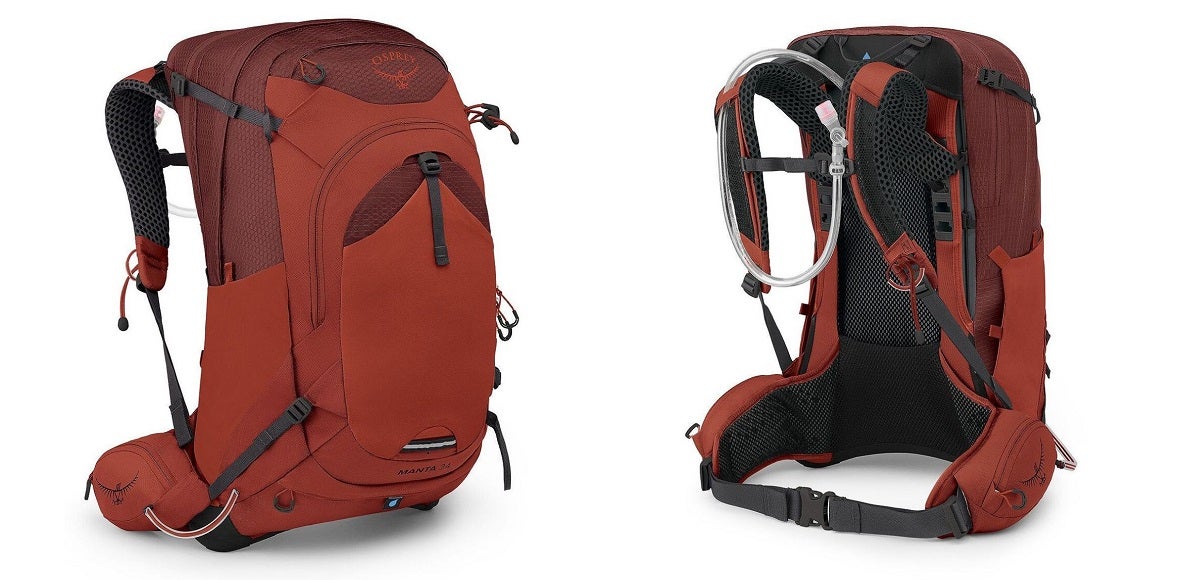

Specifications
- Water Capacity: 2.5 L
- Gear Capacity: 34 L
- Compartments: Four
- Dry Weight: 48.3 Oz.
Features
- Lightweight internal frame for added support
- Wide, adjustable cummerbund with extra padding
- Contoured yoke and shoulder straps for comfort
- Quadrant compression straps for cinching storage
- Raincover with zippered, easy-access pocket at base
- Ventilated woven mesh back and shoulder straps
- Dual zipped hip belt/cummerbund pockets
- Internal “Hydraclip” prevents bladder sag
Water is heavy. Damn heavy. Two and a half liters of the stuff weighs about 5.5 pounds. If you’re trekking beyond a simple 4-mile trail, you’re going to also need food. Add another 2 to 3 pounds. Doing an overnighter? Tack on the weight of your tent, sleeping bag, and probably some extra clothing.
All this is to say that the weight of rucking with proper hydration can quickly add up – so, if you’re doing any hiking beyond a few miles, or you’re just proper campin’, the Osprey Manta 34 is the bag you need.
This is by far the most comfortable hydration backpack you’ll don and doff. It sports a super lightweight frame (powder coated, to prevent rust), with some of the nicest straps and cummerbund available on any hydration backpack. Everything’s contoured, molded and massively padded, and finely adjustable.
Beyond simple water capacity and comfort, the Manta 34 justifies its admittedly higher-tiered price with plenty of technical hiking features. The ice tool loop and trekking pole attachment prove nifty companions on more advanced trails, while the large panel-access front pocket sports plenty of internal organizers to keep all your kit stowed neatly.
Despite its impressive capacity for water and gear, the Manta 34 remains sporty with external dimensions of 24″H, 13.8″W, and 11″D. The Manta seeks to balance dry weight and durability by combining a 210D nylon main compartment with a reinforced 420D nylon bottom.
Deuter Compact EXP 14 – Honorable Mention, Comfort


Specifications
- Water Capacity: 3 L
- Gear Capacity: 14 L
- Compartments: Four
- Dry Weight: 34.2 Oz.
Features
- “3D AirMesh”-lined shoulder straps
- Padded, adjustable cummerbund
- Ventilated back with contoured layers
- Flexible internal aluminum stays
- Removable rain cover w/ storage
- Works w/ Deuter Streamer 3.0 bladder (sold separately)
At $220, the Manta 34 can feel a bit too pricey for some – so, how about half the price for similar performance (albeit with half the gear capacity)? The Deuter Compact EXP 14 gets an honorable mention in the comfort category, thanks to its lightweight foam-and-aluminum frame, contoured and ventilated back, and adequate cummerbund with mesh straps.
It’s technically the better hydration pack in terms of capacity, too, offering 3 liters of water against the Manta 34’s 2.5 liters. And some may simply prefer a physically smaller bag with less storage capacity. The EXP 14 measures nice and tight, at just 18″ tall, 10″ wide and 7″ deep.
It sports similar features to the Manta, minus some of the technical attachments. The only drawback is that the $120 price tag lacks the hydration system – you’ll need to drop another $35 for the Deuter Streamer 3.0 bladder and hose. But you’re still coming in far below the $200 price point for a properly comfortable bag with enough water and gear capacity for overnight camping.
